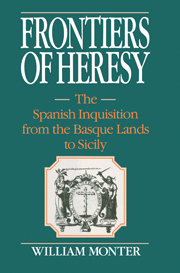Book contents
- Frontmatter
- Contents
- List of maps and figure
- List of tables
- Preface
- PART 1 THE HOLY OFFICE OUTSIDE CASTILE
- PART 2 ARAGONESE TRIBUNALS
- PART 3 ARAGONESE HERESIES
- PART 4 “MIXED CRIMES” IN ARAGON
- 12 Witchcraft: the forgotten offense
- 13 Sodomy: the fateful accident
- PART 5 RECESSIONAL
- APPENDICES
- Glossary
- Index
- CAMBRIDGE STUDIES IN EARLY MODERN HISTORY
12 - Witchcraft: the forgotten offense
Published online by Cambridge University Press: 24 October 2009
- Frontmatter
- Contents
- List of maps and figure
- List of tables
- Preface
- PART 1 THE HOLY OFFICE OUTSIDE CASTILE
- PART 2 ARAGONESE TRIBUNALS
- PART 3 ARAGONESE HERESIES
- PART 4 “MIXED CRIMES” IN ARAGON
- 12 Witchcraft: the forgotten offense
- 13 Sodomy: the fateful accident
- PART 5 RECESSIONAL
- APPENDICES
- Glossary
- Index
- CAMBRIDGE STUDIES IN EARLY MODERN HISTORY
Summary
There are no pages of European history more filled with horror than those which record the witch-madness of three centuries, from the fifteenth to the eighteenth. No land was more exposed to the contagion of this insanity than Spain … That it was repressed and rendered comparatively harmless was due to the wisdom and firmness of the Inquisition.
Lea, rv, p. 206.No vemos como acusandolos como a hereges y admitiendolos a Reconciliacion, no se deben confiscar los bienes.
Barcelona prosecutor to Suprema, 1576 (Inq., Libro 738, fol. 208).Estas negocios de bruxas suelen ser en las inquisiciones de mucho trabajo, gasto y pesadumbre, y sacase dellos poco fruto, como la experiencia lo a mostrado.
Navarrese Inquisitor to Suprema, 1595 (Idoate, Brujería en Navarra, p. 357).On February 12, 1498, the prosecutor's office of the Saragossa Inquisition began taking testimony against Narbona Dorcal, wife of Joan de Portaña of the mountain village of Cenorbe, north of Huesca. Two of her fellow-villagers, Domingo Ferrer and Pedro Jimenez, offered general and particular testimony about both her general reputation for witchcraft and her specific misdeeds. “For more than twenty years,” said Domingo, Narbona “had been reputed as a pozonyera, fetillera, and broxa” both in her village of Cenorbe “and in other parts where she had been known.” Thus begins the first preserved witchcraft trial by the Spanish Inquisition.
- Type
- Chapter
- Information
- Frontiers of HeresyThe Spanish Inquisition from the Basque Lands to Sicily, pp. 255 - 275Publisher: Cambridge University PressPrint publication year: 1990



